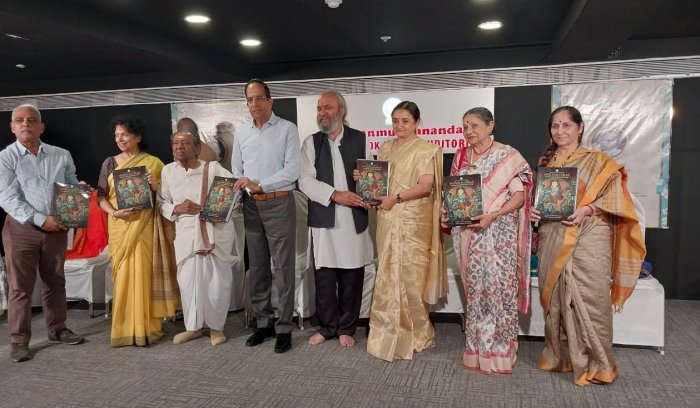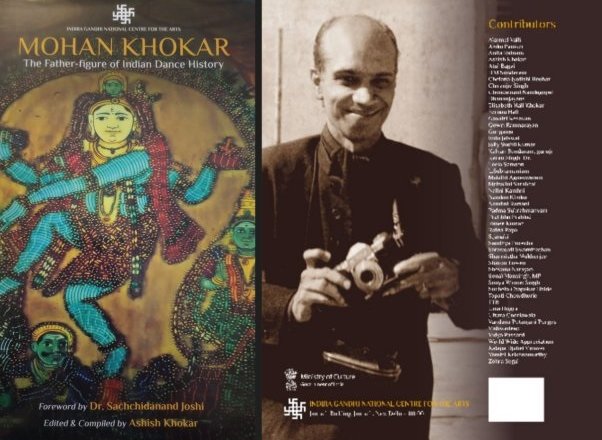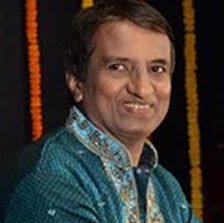
|   |

|   |
Book on 'Mohan Khokar - The Father figure of Indian dance history' released - Vijay Shanker e-mail: vijaydance@gmail.com February 25, 2024 Indira Gandhi National Centre for the Arts (IGNCA) in association with Sri Shanmukhananda Fine Arts and Sangeetha Sabha celebrated the centenary of Prof Mohan Khokar with the release of the book 'Mohan Khokar: The Father Figure of Indian Dance History', edited and compiled by his son Ashish Khokar on February 7 at the Sri Shanmukhananda Lion Ashok Mehta auditorium in Mumbai. Prior to the release of the book, a brief film on the life of Prof Mohan Khokar, pertaining to his outstanding and matchless contribution towards the propagation and enrichment of Indian dance on the global platform was screened.  The book is published by IGNCA with a grand 300 pages on Mohan Khokar. Beautifully designed, it is an amazing compilation by his equally illustrious son Ashish Khokar, well known arts personality. 50 rare articles by Mohan Khokar have been selected from thousands he wrote from 1940-2000 with the additional 50 tributes by top dancers and other personalities who were closely connected with him and his work, from Alarmel Valli to Zohra Segal and several others. Priced at Rs. 2000, it is a collector's book of archival value and can be obtained from Amazon. Reading each page shows history and heritage of Indian dance and culture and the enormous contribution of the Khokar family - Mohan Khokar, MK Saroja and Ashish Khokar. Mohan Khokar first started learning dance from Zohra Segal, the Uday Shankar style and later Bharatanatyam from Kalakshetra and was passionately interested in all forms of dance. In 1949 he married Madras Kadirvelu Saroja (M K Saroja). He was appointed the first head of the first University in India offering dance at the graduate level. At 25, he was the founder head of the University in Baroda. In 1965, he moved to Delhi and was actively associated with the Sangeet Natak Akademi. Internationally too his name and fame spread as an honest scholar, able administrator and respected critic. He was invited to most countries and conferences. He headed the UNESCO'S Asia Documentation Project and CORD conferences in USA and Europe.  The book is beautifully printed and presented with vintage value, as every article is juxtaposed with the print of the original article for the benefit of the readers. In the selection of 50 articles, the first article showcased is The Play of Rama with relation to Valmiki's Ramayana and the annual tradition of the enactment of Ram Lila in Ayodhya and other parts of Uttar Pradesh, the portrayal of the 'Maryada Purush', his ideology as the true practitioner of dharma and karma and the enormous impact on the audience, as thousands wait anxiously to witness the unique dramatic extravaganza (published in Swatantra, Nov 2, 1947). The second article is Dance in Kashmir - Part of Nature and Man (Indian Republic on Sunday, Feb 13, 1949). The third is The Devil Dances of Tibet, which is part of the religious and secular practices of the people and are essentially performed by Tibetan monks or Lamas. The demons they represent are supposed to be the nature spirits which the Tibetans held in great veneration and worshipped, prior to the introduction of Buddhism (Indian Express, Sunday Express, May 14, 1950). Pathakam and Ottan Thullal are traditional and secular dances of Kerala that gives scope to three kinds of histrionic expressions, dancing, singing and acting. Pathakam - A Traditional Dance of Kerala (Times of India, December 19, 1954) and Ottan Thullal - A Traditional Kerala Dance (Souvenir of Indian Institute of Fine Arts, Madras 1953-54), Nritya Sabha - Chidambaram's Famous Hall of Dance on biggest Shiva temple in the country (Sunday Hindustan Standard, Sept 5, 1954), Bharata Natya's Greatest Guru on Meenakshi Sundaram Pillai (Illustrated Weekly of India, Nov 14, 1954) are enlightening articles. One of the most unusual articles titled Temple of Visiting Eagles (The Sunday Hindustan Standard, October 30, 1955) is about the incredible tradition in Tirukalikunram also known as Pakshitirtham, 50 miles away from Chennai, where at noontime, eagles come to partake the 'prasadam' porridge of rice and jaggery from the hands of the priest. Tamil Ritual Dances, which are of two kinds, are Karagam and Kavadi, performed by priests who have suffered certain austerities (Anon, October 14, 1956). In E Krishna Iyer - Pioneer in the Revival of Bharata Natyam, the writer explains the unique contribution of advocate E Krishna Iyer who donned female attire in order to induce girls from respectable families to learn and practise Bharatanatyam as earlier Bharatanatyam was known as Sadir natyam and was practised by devadasis, servants of the Lords (Sunday Standard August 11, 1957). Little Known Classical Dances deals with little known styles like Koothu, Thullal and Kudiyattam besides Bharatanatyam, Kathakali, Manipuri and Kathak that are widely known (The March of India,1959). Kerala Kala Mandalam (Illustrated Weekly of India, October 30, 1960) traces the years of its existence. Gods and Goddesses in Indian dance (Roop Kala Kendra, Bombay, 1961), Egypt, World's Earliest Centre of Dancing (The Bharatiya Music and Arts Society, souvenir, 1963), The Shiva Theme in Indian Dance (Indo-German Dance review, October 1964) cover a variety of themes. The World's Oldest Ballet School (Illustrated Weekly of India, October 30, 1966) in St Petersburg, presently Leningrad, was considered the cradle of Ballet. Later, Ballet moved to Europe and America. Ghalib in Kathak (Hindustan Times, February 19, 1969), Kalakshetra - Abode of the Arts (Hindustan Times Weekly, Sunday March 23,1969), Uday Shankar Abides, a touching tribute to the great master performer (Secular Democracy, October 1977), The Saliyamangalam Plays, pertaining to the tradition of Bhagavata Mela natakams (NCPA, Quarterly journal, volume xii, no: 4, Dec 1983), A Momentous Transition pertaining to the tradition of devadasis and its varied implications (Sangeet Natak Akademi, Number 84: April-June 1987), Dances with a Brush (Sunday Review, The Times of India, Aug 4, 1991), Kuchipudi Then Kuchipudi Now (Sruti, June 1997), Male Dance in America - The Original Catalyst (Sruti, March 1997) and Dancing for Badam Halwa (Attendance, 1998) which was the last article written by Mohan Khokar before cancer claimed him in Sept 1999 offer a wide spectrum of knowledge on culture and the Arts. Other articles on Chhau, Manipuri, Odissi, Geeta Govinda, Kathak, folk dance forms etc make for absorbing reading. In the tributes paid to him by personalities from the art world and outside, one thing that comes across clear is Mohan Khokar's great passion to collect and document everything connected to dance, a passion that lasted a lifetime. In his welcome speech, Dr Shankar of Shanmukhananda said that India is among the most unique countries of the world and believes in the philosophy "Sarva Dharmam Samanvayam." Embracing all religions with equal devotion, with 28 states and 8 union territories, several languages and dialects are spoken throughout the country. In spite of such cultural diversity, unity prevails, hence Indian classical music and dance is a reflection of India's rich cultural heritage which is acclaimed internationally and he was extremely pleased to release this book on the great writer Mohan Khokar. Darshana Jhaveri said, "I was very young and it was the start of my career as a Manipuri dancer, along with my sisters Nayana, Ranjana and Suvarna. He was a simple and kind man and encouraged us a lot with his wonderful reviews of our performances. I am grateful and will always remember him and am glad the legacy moves forward with his scholar son Ashish." Veteran Kathak dancer Sunayana Hazarilal shared that, "It was the start of my career and I was looking forward to chances to exhibit my talent. I was disappointed and wrote to Sangeet Natak Akademi and did not expect any reply but was surprised to receive a reply from Mohan Khokar as he was the secretary and stated in the letter that I must meet him in the office. I went and met him and was surprised as he was so kind and understanding and organised my show and the response was amazing. I am extremely grateful to him and am happy that Ashish has taken this great initiative." Dr Sandhya Purecha, chairperson of Sangeet Natak Akademi was "extremely delighted to be releasing this great book on Mohan Khokar, the father figure of Indian dance history, and I appreciate the efforts of Ashish Khokar and Dr Sachidanand Joshi of the Indira Gandhi National Centre for the Arts. I will soon try to get it digitalised to promote wider reach and for the benefit of future dancers as well." The function was grand. Veteran guru Kalyanasundaram inaugurated and SNA chair Dr Sandhya Purecha released the book. Senior dancers present on the occasion included Uma Dogra, Daksha Mashruwala, Dr Jayshree Rajagopalan,, Uttara Coorlawala, Maya Kulkarni, Jhelum Paranjape, Malathi Agneswaram, Vasantasena, and several other young dancers like Pavitra Bhat, Sujatha Ramanathan and Sirirama.  Vijay Shankar is a Kuchipudi and Kathakali exponent, teacher, bilingual journalist, arts critic and actor. Response * Thank you for providing such a comprehensive review of the book 'Mohan Khokar: The Father Figure of Indian Dance History'. Itís wonderful to see the celebration of Prof Mohan Khokarís centenary and the release of this significant book. The compilation by his son Ashish Khokar, along with the selection of 50 rare articles by Mohan Khokar himself and 50 tributes from top dancers and personalities, truly makes it a collector's book of archival value. The rich history and heritage of Indian dance and the immense contributions of the Khokar family are beautifully showcased within its pages. The event itself, held at the Sri Shanmukhananda Lion Ashok Mehta auditorium in Mumbai, seems to have been a grand affair, attended by esteemed dancers and dignitaries. Kudos to IGNCA and Sri Shanmukhananda Fine Arts and Sangeetha Sabha for organizing such a momentous occasion. This book undoubtedly stands as a testament to the lifelong passion and dedication of Prof Mohan Khokar and his invaluable contributions to the world of dance. Itís heartening to know that his legacy lives on through this remarkable publication. - Jahanshah (Feb 25, 2024) |